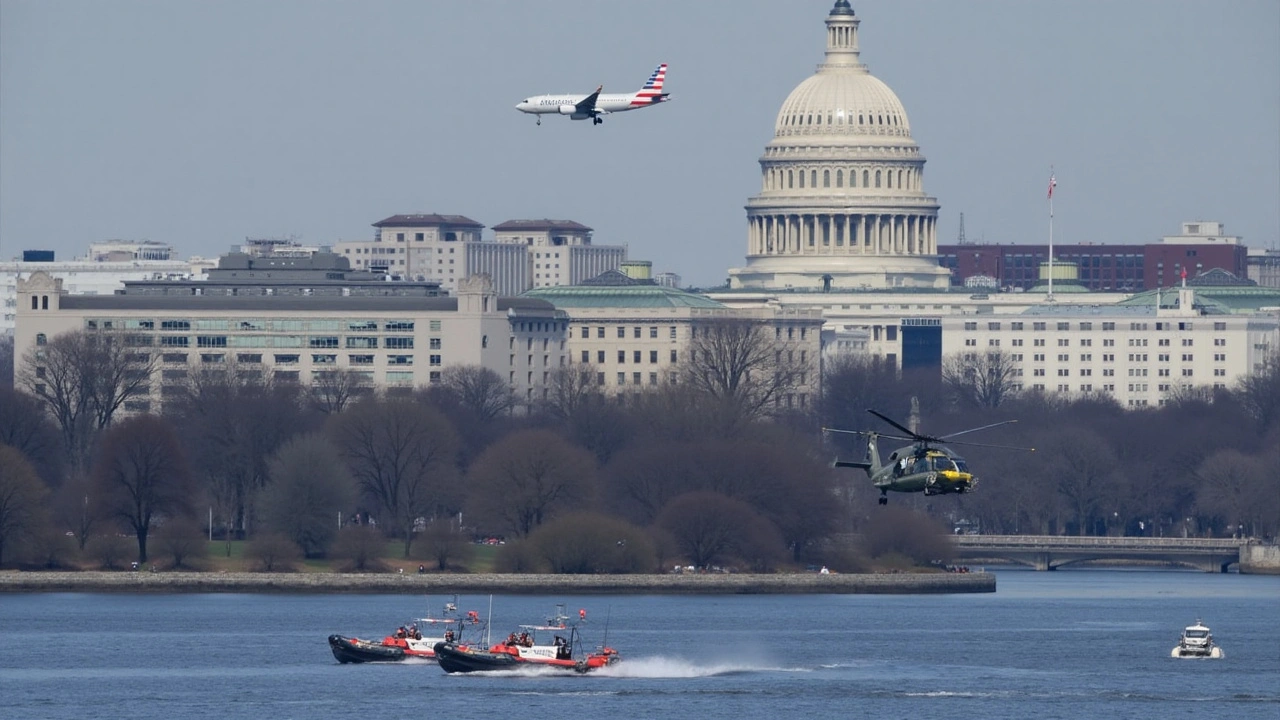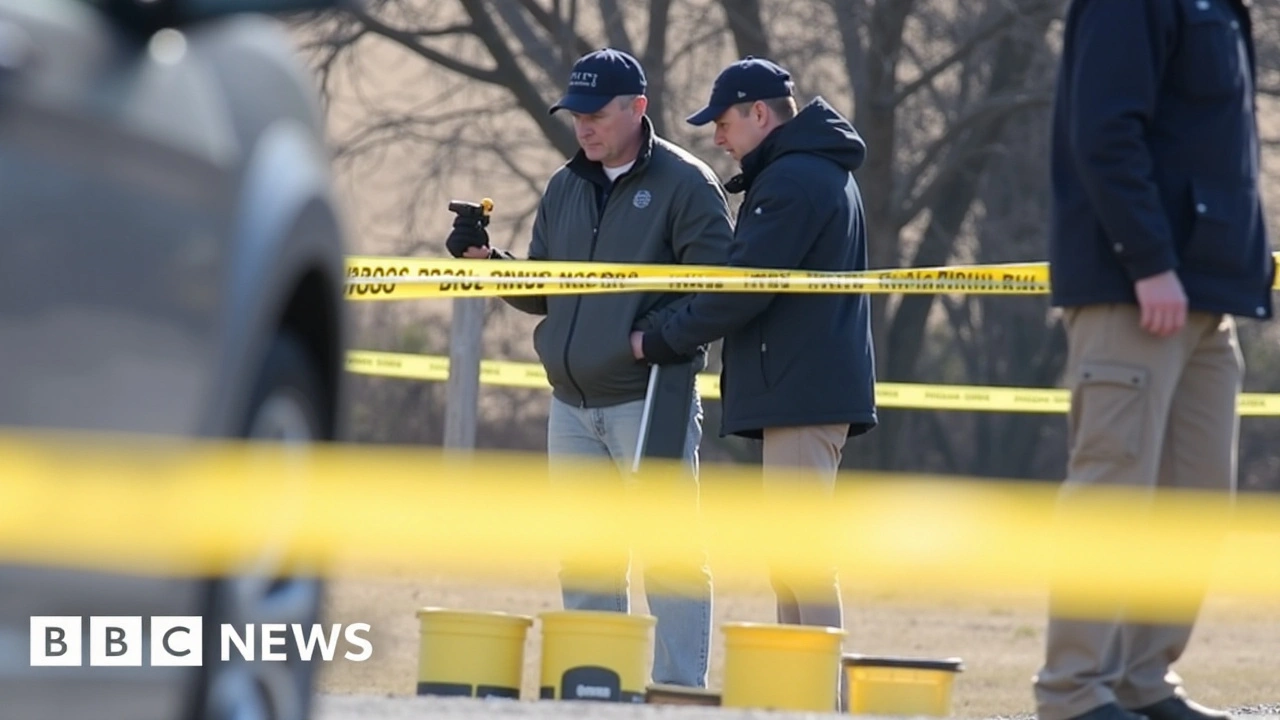Search for Survivors After D.C. Plane and Helicopter Crash in Potomac River

Tragedy Strikes Over Washington D.C. with Mid-Air Collision
A devastating accident has gripped the nation’s capital following a tragic mid-air collision over the Potomac River. In a calamitous event on January 31, 2025, an American Airlines regional jet bound for Reagan Washington National Airport collided with a Sikorsky H-60 Black Hawk helicopter belonging to the U.S. Army. In moments, both aircraft plummeted into the frigid waters of the Potomac, casting a somber shadow over Washington, D.C., and beyond.

Details of the Collision Emerge
The accident involved a PSA Airlines Bombardier CRJ700, which had originated from Wichita, Kansas. The plane was nearing the completion of its journey, approaching Runway 33 when disaster struck. Concurrently, the U.S. Army helicopter, stationed at Fort Belvoir in Virginia, was engaged in a routine training exercise. The ensuing collision left both aircraft unrecognizable, strewn across the cold river in broken fragments. Reports confirmed that the crash claimed the lives of at least 41 individuals, comprising both passengers and crew from the jet and military personnel aboard the helicopter.

Rescue Operations and Grounded Flights
First responders heroically rushed to the scene, navigating the treacherous waters in the hopes of rescuing survivors. Unfortunately, as the hours passed, no signs of life have been detected among the debris. The crisis response has centered around three major debris fields, where rescue divers and sonar-scanning boats focus their efforts. In coordination with federal agencies, extensive search operations continue, underscoring the grave reality that time is of the essence. Meanwhile, Reagan Washington National Airport remains temporarily closed to ensure all resources are dedicated to the ongoing rescue and recovery efforts. Air traffic control meticulously orchestrates flight rerouting, mitigating broader impacts on air travel as the airport aims for a reopening timeline of February 1 at 5 a.m.
Federal Aviation Administration and Presidential Response
The Federal Aviation Administration promptly confirmed the collision, shedding light on the scope and nature of the catastrophe. FAA officials are collaborating with the National Transportation Safety Board (NTSB) in investigating the incident, aiming to determine how such a tragic collision could have occurred. Concurrently, President Trump extended heartfelt condolences to the victims’ families. Expressing gratitude to the first responders for their swift efforts, the President assured that the full breadth of federal resources will be directed towards uncovering the causes of this unfortunate event.
Heartfelt Appeals and Confidentiality Respect
In a rare public appeal after the incident, families of the affected individuals have called for compassion and patience amidst the unfolding tragedy. They have requested respect for their privacy, as the U.S. Army adheres to the wishes of one family by withholding the identity of a deceased soldier. This decision emphasizes the human impact of the tragedy, reminding the public of the personal stories entwined with the incident. As investigators dissect the factors leading to this disaster, the community grieves for lives lost and holds onto hope for any potential survivors.
Future Safety Measures and Learnings
As the rescue operations continue, the broader focus will inevitably shift towards aviation safety improvements. Incidents such as these provoke critical examination among stakeholders, compelling an unwavering commitment to enhance air traffic control systems and pilot training programs. The interplay between commercial and military aviation functions within the congested Washington, D.C. airspace highlights a crucial point of consideration for procedural reforms. Officials are determined to ensure that the painful lessons from this incident lead to substantial, life-preserving changes in the future of aviation safety.
17 Comments
Eduardo Lopez
It is a harrowing reminder that the skies over our capital are not exempt from the moral failings of complacency.
When a commercial jet and a military helicopter collide, we must ask ourselves whether our regulatory frameworks are mere afterthoughts rather than ironclad safeguards.
We have witnessed far too many cut‑corners in aviation, and this tragedy starkly exposes the consequences of such negligence.
Our collective responsibility is to demand rigorous oversight and to refuse to accept any laxity in air traffic control procedures.
This is not a matter of political point‑scoring; it is about preserving human life with uncompromising standards.
The FAA and NTSB must be empowered with the resources to conduct exhaustive investigations without political interference.
Every protocol, every communication channel, every radar sweep should be scrutinized for potential failure points.
We owe it to the families mourning their loved ones to ensure that no future flight is jeopardized by bureaucratic inertia.
It is incumbent upon every citizen to vocalize the necessity for transparent reporting and accountability.
Only through relentless public pressure can we hope to see meaningful changes implemented across both civilian and military aviation sectors.
The tragedy also underscores the need for better coordination between commercial airlines and the armed forces operating in shared airspace.
Joint training exercises must be harmonized with civilian flight paths to eliminate dangerous proximity risks.
Safety drills should incorporate realistic scenarios that reflect the complexities of modern, congested skies.
Furthermore, pilots should receive continuous education on emerging technologies and situational awareness tools.
In short, this calamity should serve as a catalyst for sweeping reforms that prioritize life over convenience.
Let us honor the victims by committing to a future where such senseless loss is impossible.
Susan Mark
First off, my heart goes out to everyone affected – the rescue teams are doing everything they can, but the river's conditions are brutal.
Divers are using side‑scan sonar to map debris fields, and they’re pulling out fragments bit by bit.
Anything that surfaces is cataloged for investigators, which helps piece together what happened.
Even though the odds are low, they’re not giving up, and that persistence can sometimes turn up a survivor.
If you want to help, consider donating to the families' relief fund that’s been set up by local charities.
Alex Lee
The whole thing is just a messed up publicity stunt.
Vida Yamini
Hey everyone, I just want to take a moment to acknowledge how overwhelming this news can feel.
When we read about something as tragic as a mid‑air collision, it’s easy to get lost in the raw numbers and forget the human stories behind them.
Remember to be gentle with yourselves – it’s okay to feel sad, angry, or even numb.
If you’re sharing this story online, try to keep your language respectful, avoid sensationalist phrasing, and double‑check any facts you quote.
For those of you who are writers, a good tip is to use short paragraphs and keep sentences varied in length; it makes the narrative easier to digest.
Also, watch out for common grammar pitfalls like mixing up “its” and “it’s” or over‑using commas where a period would be clearer.
Keeping your tone compassionate while staying factual helps maintain credibility and empathy.
Lastly, if you’re supporting a fundraiser, a simple, heartfelt message often does the most good – no need for over‑the‑top dramatics.
James Lawyer
In reviewing the operational timeline, it appears that the coordination between the FAA and military flight plans may have suffered from a lapse in real‑time data exchange.
The standard protocol calls for a shared trajectory overlay, yet the records suggest a delay of several minutes in updating the joint situational awareness interface.
This type of latency can significantly degrade the decision‑making window for both civilian and military pilots.
Given the high traffic density in the D.C. corridor, any such discrepancy is a serious safety concern.
Future recommendations should include redundant communication channels and automated conflict detection algorithms to mitigate human error.
Nancy Perez de Lezama
Look, I think the whole investigation is being handled in a very slow and bureaucratic way.
The families are waiting for answers, and the officials seem more interested in protecting their image than giving transparent updates.
Honestly, it feels like they’re dragging their feet to avoid any accountability.
Matt Heitz
From a national security perspective, this incident exposes a systemic vulnerability in our integrated airspace management framework.
The convergence of NATO‑aligned commercial routes with Department of Defense training corridors was insufficiently deconflicted, leading to an unacceptable risk profile.
Our aerospace regulatory bodies must adopt a unified command‑and‑control architecture that leverages ADS‑B data fusion, real‑time conflict resolution algorithms, and enforceable separation minima.
Only through a strategic overhaul can we safeguard both our civilian passengers and our service members.
Jason Jennings
All this talk about safety ignores the fact that our own military pilots often get special treatment, cutting corners that civilian crews have to follow.
Diego Vargas
Look, i realy think the root cause is simple: lack of proper synced comms between the two flights.
When you dont have the same situational awareness, a crash is inevitable.
Also, the training protocols for the h‑60 need to be updated to include more realistic traffic scenarios.
Abby Culbertson
i cant even imagine how the families feel. someting just feels so wrong about all this.
Awolumate Muhammed Abayomi
Friends, let’s channel our energy into supporting the rescue crews – they’re working nonstop, and a kind word or a donation can really boost morale!
Josh Tate
i hear you. its so hard to stay calm when news like this hits. just remember to take a breather and check reliable sources for updates.
John Smith
Honestly, most people don’t realize that the FAA has been underfunded for years, which directly impacts their ability to monitor complex airspace like the one over D.C.
When budget cuts force staff reductions, you get gaps in surveillance and slower response times.
That’s why this tragedy is almost inevitable under the current system.
Alex Soete
Let’s keep the conversation constructive – we can all push for better funding and modern tech upgrades to prevent future accidents.
Every voice matters, so share this info and keep the pressure on lawmakers!
Cara McKinzie
Wow, another disaster and nobody seems to learn anything! The headlines will be gone tomorrow, and the same mistakes will happen again.
Joseph Conlon
While everyone is busy pointing fingers, it’s worth noting that the air traffic control system itself has been riddled with legacy software that can’t handle modern traffic densities.
Even if pilots were perfectly trained, outdated radar integration and delayed data feeds create blind spots that are practically a ticking time bomb.
Therefore, the blame isn’t just on the crews; it’s embedded in a systemic failure that demands a complete technological overhaul.
Mohit Singh
People need to stop sugar‑coating this – it’s a disaster born from negligence, and we should be furious enough to demand real, immediate change.


Write a comment